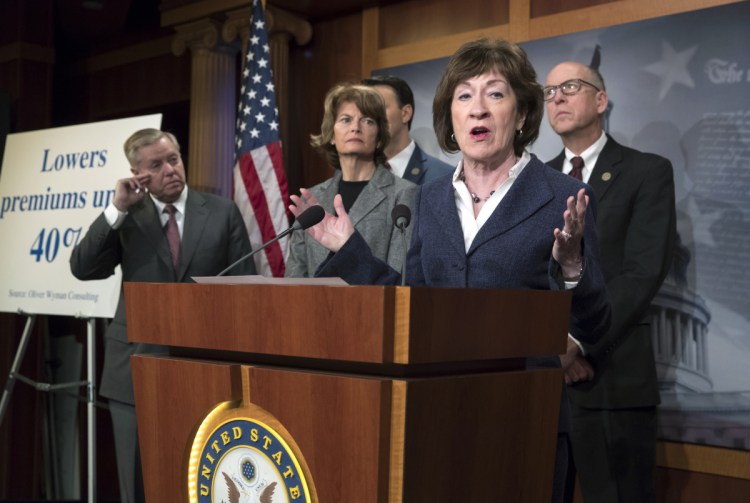This fall, millions of Americans who are already struggling to afford health insurance will once again experience double-digit premium increases because of election-year politics at its worst. What is most regrettable is not only that those increases could have been prevented but also that the cost of health insurance actually could have declined by as much as 40 percent in the individual market over the next two years.
A great deal of misinformation about the effort I helped lead with Sen. Lamar Alexander, chairman of the Senate Health Committee, to prevent these health insurance premiums from skyrocketing has appeared in Maine newspapers. I thought it would be helpful for me to tell you what happened.
For the past few years, instability in the health insurance market has led to dramatically higher premiums and fewer choices for consumers. I have long believed that members of both parties needed to work together to repair our health care system.
OPPOSING INDIVIDUAL MANDATE
The tax cut plan recently addressed one key area long in need of a solution: the Affordable Care Act’s individual mandate, a burdensome, regressive penalty that I have never supported. And I’m not alone. During the debate on the tax cut plan, no Democrat – not a single one – offered an amendment to keep the individual mandate.
The individual mandate was so unpopular because it forced Americans to buy insurance they could not afford. Eighty percent of the individual mandate fines were paid by families making less than $50,000 a year.
Although I have always opposed fining people who did not purchase insurance, I did not think the individual mandate’s repeal should have been linked to the tax cut plan because without additional fixes to the ACA, repeal of the mandate would shrink the size of the insurance market, spreading the risk among fewer people.
But let me be clear: I supported the tax cut plan – and would support it again today – because it will help lower-income and middle-income families keep more of their hard-earned money, boost the economy and encourage businesses, both small and large, to grow and create jobs here. We are already seeing the benefits of this law in Maine and throughout the country.
I also worked to improve the tax bill, authoring provisions to allow taxpayers to deduct up to $10,000 in state and local taxes, to restore and expand the deduction for high medical bills and to reverse ill-advised retirement changes that would have harmed firefighters, police officers and schoolteachers. And I successfully led an effort to avert a potentially devastating $25 billion cut to Medicare.
TWO BIPARTISAN PROPOSALS
In addition to these priorities, I advocated for two bipartisan proposals that would offset the impact of eliminating the mandate without fining those who could least afford it and would actually lower health insurance premiums substantially. These proposals were the product of months of bipartisan negotiations, hearings and roundtables.
• The first was based on the bipartisan bill sponsored by Sens. Alexander, a Republican from Tennessee, and Patty Murray, a Washington state Democrat, that would fund subsidies that help with high out-of-pocket costs like co-pays and deductibles for Americans with incomes below 250 percent of the poverty level.
• The second was a reinsurance bill I authored with Democratic Sen. Bill Nelson of Florida, which would provide a total of $30 billion over three years for states to create reinsurance or invisible high-risk pools. Reinsurance is a proven method of dealing with high-risk, expensive claims and has been used successfully in states like Maine and Alaska. It reduces uncertainty and lowers premiums not only for those who have pre-existing conditions and need expensive health care, but also for consumers in the entire individual market.
According to the health care experts at the consulting firm Oliver Wyman, our bills would have lowered health insurance premiums in the individual market by as much as 40 percent compared to what people will otherwise pay. They also would have expanded coverage to an additional 3.2 million individuals.
Dozens of health care, consumer and business groups, as well as AARP and the National Association of Insurance Commissioners, called on Congress to take action to lower premiums for millions of Americans and their families.
Congress faced a fundamental question: Were we going to act to significantly reduce the cost of health insurance for millions of Americans, or were we just going to sit back, say “no” and let this opportunity pass us by?
REOPENING ABORTION DEBATE
The most logical vehicle for our proposal was the “must-pass” overdue government funding bill, which is subject to the Hyde Amendment. This law, which has been in place for more than four decades, prevents federal funds from being used to pay for elective abortions. It applies to a long list of federal health programs, including Medicare, Medicaid, CHIP, TRICARE, Veterans Affairs, Indian Health Service, the Peace Corps, Bureau of Prisons, Immigration and Customs Enforcement and the Federal Employees Health Benefits Program. Together, these programs account for well over $1 trillion in government spending each year – all of which is covered by the Hyde Amendment. That’s a hundred times the amount of reinsurance funding that our health care reforms would have provided.
Sadly, hyperpartisanship has reached a fever pitch in Washington. Although federal funding has not been used to pay for elective abortions for decades, some Democrats reopened the long-settled debate on the Hyde Amendment in order to block these much-needed insurance reforms.
This proposal was the last clear opportunity to prevent these health insurance rate increases, which will be announced Oct. 1. The most frustrating thing about these imminent price increases is that they were entirely avoidable. Much about health care is complicated. This, by contrast, was a resolvable problem with a straightforward solution that would have benefited millions of Americans.
— Special to the Telegram
Send questions/comments to the editors.



Comments are no longer available on this story